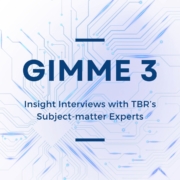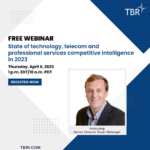Analytics, AI and digital transformation reach tipping point in acceleration
Gimme 3 — Insight Interview with TBR’s Subject-matter Experts
In TBR’s new blog series, “Gimme 3 — Insight Interview with TBR’s Subject-matter Experts,” Principal Analyst Patrick M. Heffernan discusses our latest and most popular research with our analyst team. This month Patrick chats with Principal Analyst Boz Hristov, who leads TBR’s Digital Transformation (DT) research portfolio and is the primary author of the Digital Transformation: Analytics Professional Services Benchmark. They discuss innovation-centric investments and vendor-specific changes in the analytics and AI space.
Patrick: In TBR’s January 2023 Digital Transformation: Analytics Professional Services Benchmark, you wrote, “We believe many of the innovation-centric investments vendors pursued over the past 12 to 18 months have paved the way for growth in the A&I segment, particularly as buyers seek to automate processes from knowledge work to cloud and enterprise applications.” Can you explain that connection between the vendors’ innovation-centric investments and the buyers’ desire to for more automation?
Boz Hristov: Innovation and cost optimization often go in opposite directions in terms of budgets and cycle adoption. Automation and analytics, on the other hand, are centered on vendors’ ability to gain trust within their analytics models and algorithms. Given the maturity of the DT market, buyers often demonstrate a willingness to experiment if new technologies provide business outcomes without disrupting ongoing operations, which has led ecosystem participants to invest in developing solutions.
Meanwhile, there are two main forces shaping TBR’s outlook. First, the constant nudging from technology vendors with new solution ideas has forced incumbent vendors to stay abreast of innovating their portfolios, thus helping them capture analytics and insights opportunities, provided each party in the alliance establishes relationship governance guardrails. Second, the need for reducing and managing expenses to weather macroeconomic headwinds will further necessitate the adoption of AI and analytics tools, allowing buyers to gain visibility into process inefficiencies.
Patrick: You also wrote that, “While virtually every vendor we cover touts a technology-agnostic go-to-market strategy, we expect buyer sentiment and the need for developing pointed solutions to drive a shift in behavior and messaging among services vendors.” What are some examples of IT services vendors or consultancies that have started that pivot in behavior and messaging?
Boz: Each vendor maintains a strong value proposition, demonstrated by steady performance at the corporate level, largely fueled by cloud. Thus, opportunities are ripe for vendors to demonstrate the value of their algorithms when it comes to managing enterprises’ DT programs from IT operations to finance and HR processes. All vendors, though, must remain mindful of the impending macroeconomic slowdown and how they demonstrate the value of their analytics solutions. To remain successful, vendors will need to manage their partner ecosystems differently, as no vendor can do it alone. As services vendors retune their partner messaging and go-to-market efforts, analytics provides a strong use case, helping vendors pivot from being vendor agnostic to capability aligned.
For example, Deloitte has pursued significant portfolio expansion with Amazon Web Services (AWS), Google Cloud and Salesforce as the firm strives to compete for AI-enabled, enterprisewide DT opportunities. Deloitte launched cyber cloud-managed services for AWS. The two also are co-investing in enhancing Deloitte’s recently launched ConvergePROSPERITY banking suite, making it available on AWS using Amazon Connect for contact center support and Amazon Connect Cases for call center case management, Amazon Pinpoint for customer engagement management, and Amazon Cognito for end-user security. With Google Cloud, the two recently announced a significant partnership expansion, which will include Deloitte training and certifying staff on the Google Cloud Platform (GCP) tech stack; codeveloping industry offerings for retail, consumer packaged goods (CPG), financial services and the public sector; and offering specialization around SAP in Google Cloud, AI/machine learning (ML) and security capabilities.
At the EY Global Data and AI Summit, EY demonstrated its willingness and readiness to partner better and differently. During one of the panel discussions, EY brought six of its data and AI partner companies ranging in size and portfolio offerings to present on stage: Databricks, IBM, Microsoft, RelationalAI, Snowflake and UiPath. The companies presented in alphabetical order so EY could avoid being accused of favoritism, a smart move further confirming EY’s willingness to partner better and bring parties together not just in a press release but also to clients. EY’s approach to partners is different from many of its peers’ as the firm does not go to market with a particular vendor unless EY uses that vendor internally. Adopting a customer-zero approach to its alliance partners elevates EY’s trustworthiness, a key element in the firm’s efforts to act as an ecosystem enabler.
Patrick: Stepping back from the specifics in the report, what’s something you’ve seen change over the last few years in the analytics, AI and automation space that either you didn’t expect or maybe changed faster than anticipated?
Boz: The role of cybersecurity remains invaluable, especially as DT programs mature and the volume of customer and enterprise data increases exponentially with the implementation of new technologies such as cloud, the edge, 5G, IoT and the metaverse. This evolution has created a federated environment for DT programs, compelling ecosystem participants to adopt more accountability and a collaboration mindset, rather than pushing the next technology from their sales toolboxes. Recent developments — such as the formal launch of OpenAI’s ChatGPT bot, which provides sophisticated responses to users’ queries, based off a large amount of data — present a strong use case for how AI can be both useful and harmful when it comes to cybersecurity. From writing phishing emails to trying to bypass OpenAI’s cybersecurity guardrails in order to develop malware attacks, malicious actors could use the technology to explore customers’ and enterprises’ vulnerabilities enabled by AI.
TBR believes AI and automation adoption have reached an inflection point and are ripe for further acceleration, especially as the former provides insights into business transformation revenue growth opportunities and the latter enables cost-efficiency optimization, both necessary tools in helping enterprises weather macroeconomic headwinds. Misusing AI, automation and analytics in managing cybersecurity could backfire and jeopardize clients’ trust in vendors’ models and algorithms, something they have worked for a while to establish, necessitating better ecosystem collaboration to improve processes integration and standardization.
Patrick: Summing up, then, Boz, I think you said “ecosystem” or “alliance partners” about 10 times, reinforcing what we’re hearing across the IT services professional services and digital transformation space. It’s all about playing nicely in the sandbox. Of course, others have to want to play with you, but sounds like the vendors you’re covering aren’t questioning their own capabilities, just trying to work better across the ecosystem.
Fill out the form below to receive weekly free resources and upcoming webinar invitations

 Technology Business Research, Inc.
Technology Business Research, Inc.
 Technology Business Research, Inc.
Technology Business Research, Inc.
Leave a Reply
Want to join the discussion?Feel free to contribute!